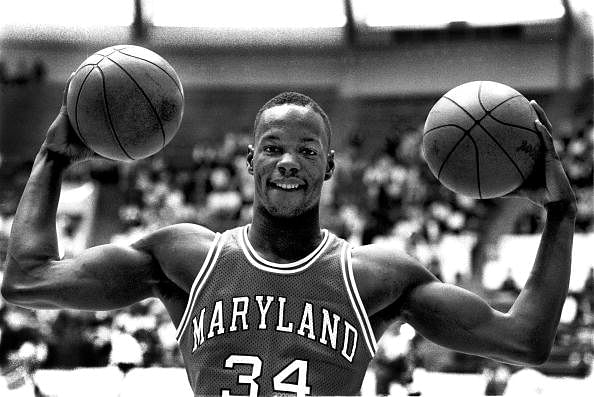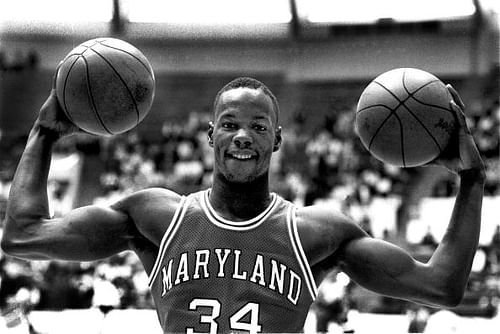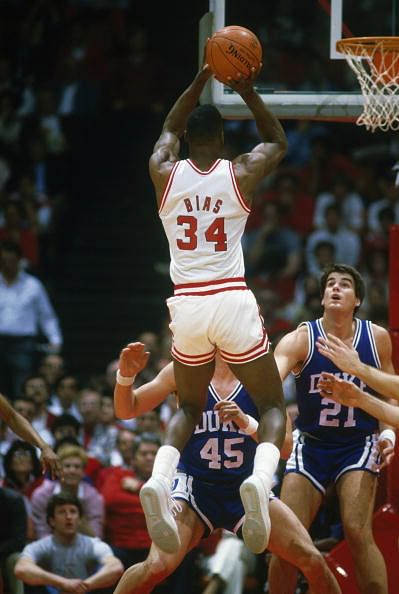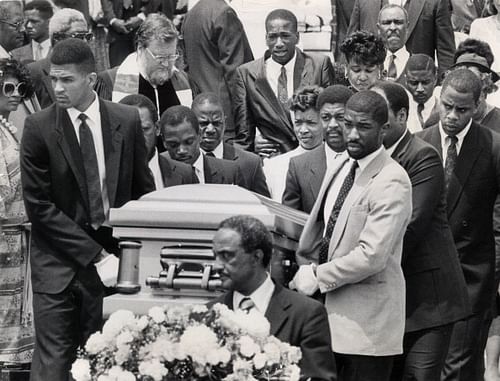
Remembering Bias: What basketball lost in 1986

Sometimes, when sport meets reality, an individual can become something bigger than himself, an emblem, the very essence of something. He becomes something much greater, something that people will remember long after he is dead, after eras end. They call it many things – immortality, legacy, inspiration. When this happens, he becomes a symbol of our triumph and enduring spirit. Or he becomes the symbol of the very tragedy we turn to sports to escape. In NBA history, there are two such names.
One is Michael Jordan, the basketball messiah, a gift of the Gods. A transcendental athlete with an impeccable work ethic who is now synonymous with the game of basketball worldwide. When we think of champions, we think of Michael. When we think of greatness, we think of Michael. When we think of fortitude and commitment in sports, we think of Michael Jordan.
The other name is everything we choose not to think about in sports. To talk of Len Bias, All-American, almost Boston Celtic, is to puncture the fantasy of sport. To talk of Len Bias is to talk of everything that scares us, what sports cannot somehow wish away. As eras pass, Jordan’s immortality will only be reinforced. There are already biographies, encyclopedias of Jordan’s achievements, thousands of hours of game tape. Len Bias is nothing more than a eulogy, few paragraphs in a feature on the tragic character of sport. That Len Bias ever played the game of basketball will be forgotten. Basketball memory is selectively amnesiac; tragedies are forgotten and heroics are writ in stone.
That once upon a time, everybody in the basketball universe believed him equal in ability to Jordan will be forgotten.
That once upon a time, the legendary Red Auerbach plotted and schemed for three whole years to draft Len Bias no. 2 in the 1986 NBA Draft will be a mere footnote, nothing more.
 Once upon a time, Len Bias was an extraordinary basketball player. He could leap over the moon, had the purest jump shot (in history, according to ESPN’s Michael Wilbon) in college basketball, could run, could block, could rebound and could do amazing, unbelievable things with a demeanor of casual nonchalance. Watching him play, it’s impossible to not be reminded of MJ. Bias had the same swagger, the same ability to carry his team in crunch time. It was impossible not to root for Bias given that he always played for an underdog team.
Once upon a time, Len Bias was an extraordinary basketball player. He could leap over the moon, had the purest jump shot (in history, according to ESPN’s Michael Wilbon) in college basketball, could run, could block, could rebound and could do amazing, unbelievable things with a demeanor of casual nonchalance. Watching him play, it’s impossible to not be reminded of MJ. Bias had the same swagger, the same ability to carry his team in crunch time. It was impossible not to root for Bias given that he always played for an underdog team.
Len, or ‘Frosty’, as he was called by friends and family, was not heavily recruited out of high school. He was offered a basketball scholarship to play with his home state University of Maryland Terrapins team and he took it, simple as that. He didn’t make the starting five at his freshman season’s tip-off but was firmly in it by season’s end. Flashes of raw talent and potential had already enamored several scouts and sportswriters. The combination of a 6’8” muscled frame with the sort of leaping ability few are blessed with mostly translates into NBA stardom. This was in 1983. By his junior year (1985), he led the ACC in scoring (19 ppg). By 1986, he was pure magic on a ball court. In his final year at Maryland, Len averaged 23 ppg and 7 rpg on 54% shooting.
By June 17th, 1986, Len Bias was drafted by the then defending champion Boston Celtics. It had been Len’s life-long dream to play for the Celtics. Red Auerbach had somehow parlayed a mediocre player (Gerald Henderson) and picks in 1984 for what turned out to the #2 overall pick in the 1986 Draft. And Auerbach had Bias in mind when he made the trade. On June 19th, 1986, two days after experiencing the best high in sports, Len Bias succumbed to cardiac arrest induced by cocaine overdose.
Perhaps he was naïve, perhaps he was just some guy who wanted to celebrate ‘living the dream’. Whatever it was, the night Len got back from New York (where the Draft took place), he drove up to his college dorm and partied with his teammates. There was booze, there was crack cocaine; after all, all the “stars” in the 80s were hooked to coke, a ‘new’ drug back then. Perhaps Len knew what he was doing, more likely he didn’t. Narco tests on the coke consumed suggested that it was high-end pure coke – the sort that very few people have access to. Maybe Len knew how potent and dangerous it was. Maybe he didn’t. What’s certain is that nobody – not family, not friends, not his coach – saw this coming. Len Bias simply did not consume drugs as far as anybody could tell.

Len Bias’ casket is carried by pallbearers
The repercussions were enormous. Later, writers and commentators called it the ‘Kennedy moment’ of a new generation. The collective populations of Boston and Maryland were shocked, they couldn’t believe it. This was sports and Len Bias was the chosen one – he was to be the guy who prolonged Larry Bird’s career, whose play would deliver not five, not six, not seven championships to Boston Gardens. Len Bias had just signed a $3 million deal with Reebok; Len Bias was going to be an NBA superstar, as good as Jordan, as most scouts and writers who watched him claim. And just like that, Len Bias was a body in a bag and that was sports at its most heart-breaking and cruel avatar. It shook the Bias family, maybe changed things forever. The aftermath of Bias’ death saw several tough questions being asked of drug laws and the US Congress. By 1988, the Congress had drafted a strong law cracking down on drug peddling. It was called the Len Bias law. Len’s brother, Jay, a promising basketball talent himself, was shot dead over a petty argument in 1989. In a four year span, the Bias family had lost two bright sons to drugs and guns, a strong indictment of American culture.
Just like that, the Bias family went from American Dream to Bust. This is the story that we do not want to hear about in sports. After all, sports is not ‘real life’…what sportsmen do, they’re not ‘real jobs’. But now, Bias has ceased to be a basketball player. He has become the emblem of the drugs-NBA story, a tragedy – a warning. Michael Jordan’s highlights are ubiquitous, and Bird’s basketball legacy is more than safe with the Celtic die-hards. Once upon a time, Len Bias was a great basketball player too. And then, by luck, by fate, by cruel chance, by stupidity…
The first bouquet of flowers that Lonise Bias, Len’s mother, received after Len’s death was from Michael Jordan. It was a bouquet of peonies, she remembers. The second was from Larry Bird.
The greatest story one can tell of Len Bias is the University of Maryland Terrapins versus University of North Carolina Tar Heels at Chapel Hill, 1986. The Tar Heels were a near-unbeatable top-ranked team, featuring future #1 pick Brad Daugherty and boasting of a 25-1 record in the ACC. Bias’ Terrapins were 14-11 for the season, unranked and not on anybody’s radar.
But they had Len Bias.
With just about 3 minutes to go and the Terrapins down by nine, Bias stole the ball on an inbounds play and before you could say ‘incredible’, reverse-dunked it as a Tar Heels team looked on in bewilderment. A reverse-dunk in clutch time. The Terrapins tied the game and won it in overtime. Bias alone outscored the Tar Heels 8-4 in clutch time on a range of smooth jumpers and layups, totaling 35 points for the game. At the end of it, the Terrapins were ecstatic, hugging and falling all over Len. He was a hero.
The Len Bias story is not just about drugs; it’s about a basketball player who had it all, only for it to be incomprehensibly taken away just as it was in his grasp. It’s about the cruel randomness of sports and the tragedy of a family – just another family. It’s the story of what basketball lost when it collided with reality and that’s every bit as important as each of MJ’s six rings.